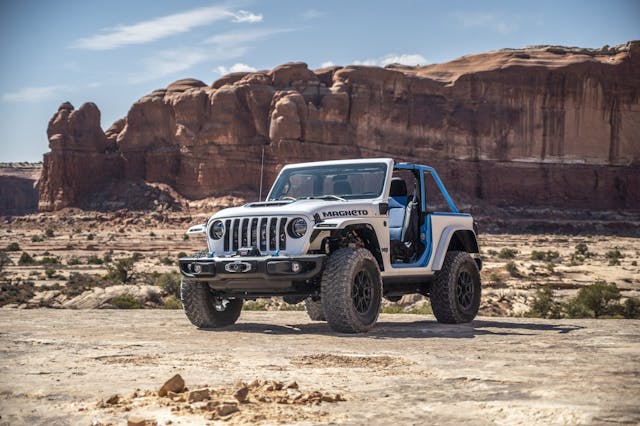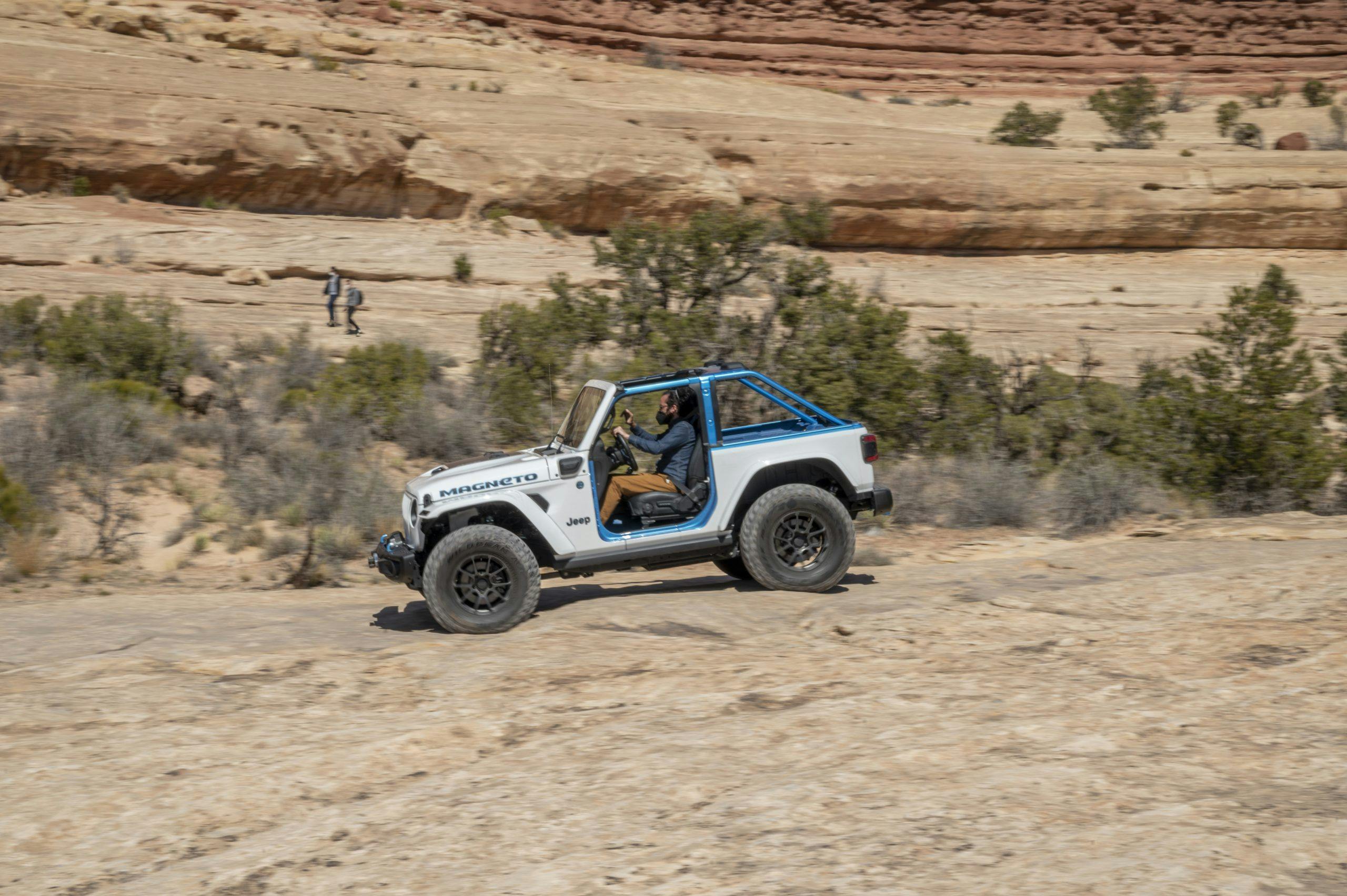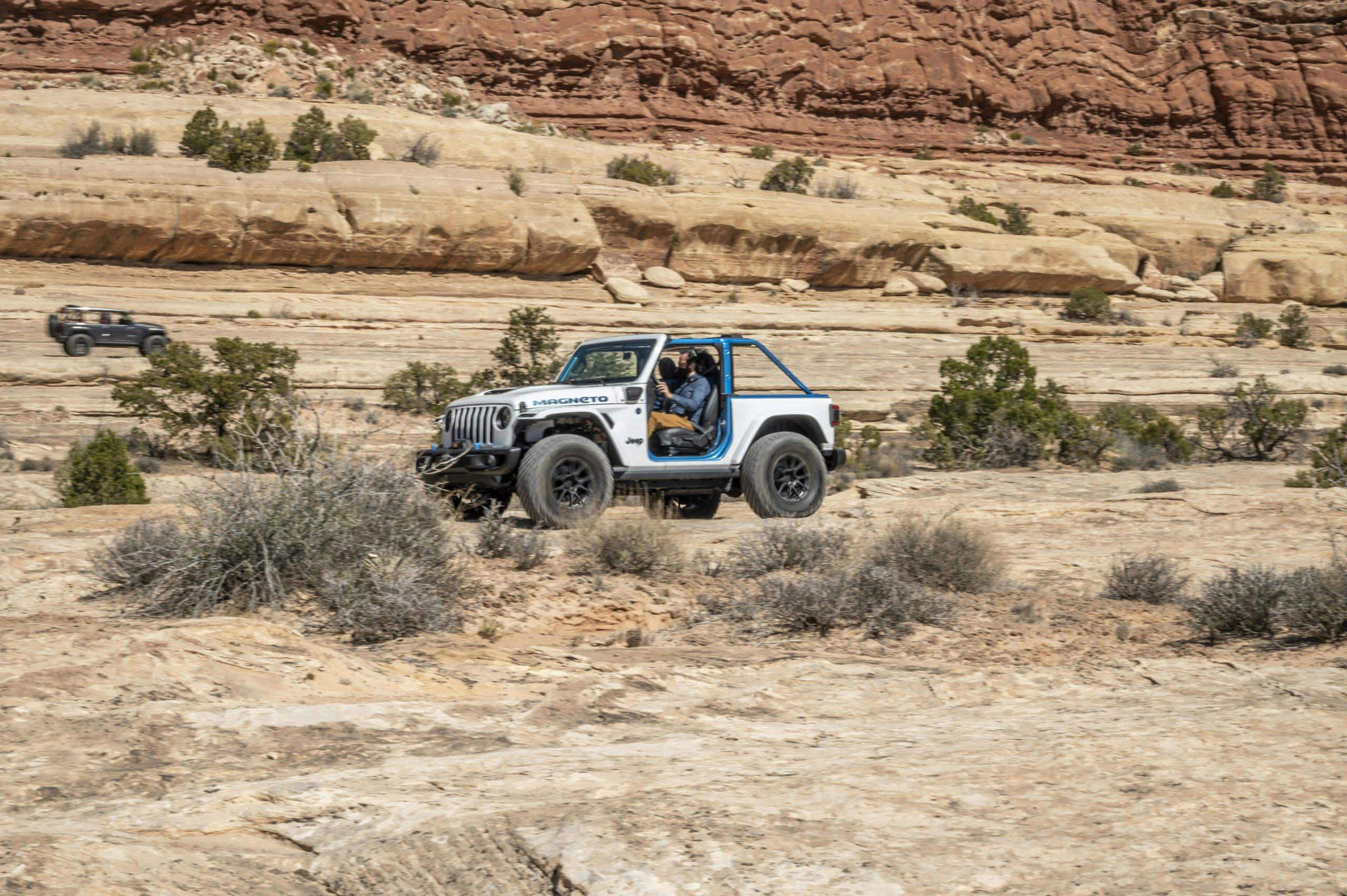Magneto in Moab: Off-roading Jeep’s electrified comment box
While EVs and hybrids are no strangers to public roads these days, they’re still left behind at the gate when it comes to most off-roading adventures. This situation doesn’t represent an inherent flaw in electrified powertrains as much a lack of development for this specific application. Passenger cars driving on the street have been the focus of EV innovation, and even with upstart companies like Bollinger and Rivian tackling the challenge, and GMC on the cusp of relaunching the Hummer sub-brand, we’ve yet to see all-electric trucks and SUVs proliferate off-road.
Jeep is studying what a battery-powered rock-crawler could and should look like, and is open about its electric Wrangler Magneto concept being an early prototype. The concept’s debut in Moab, at the 2021 Easter Jeep Safari, was strategic. Instead of squirreling the project away during development and later thrusting it out from behind the curtains, engineers are eager for the world to examine and criticize the idea. By engaging with its customer base in this way, Jeep hopes to refine the concept into a production variant that will satisfy fans. With that in mind, what is the Magneto, really? An electrified comment box for the 4×4 enthusiast.
With so many preconceived notions about what an EV is and isn’t capable of, the whole concept of an all-electric Wrangler might seem strange. Jeep built its whole reputation on off-road dominance, so reconciling its core product with the impending bans on combustion engines and the unshakable expectations of its dedicated community is a major challenge. Compromising capability is out of the question, unless an angry mob storming Auburn Hills is the goal.
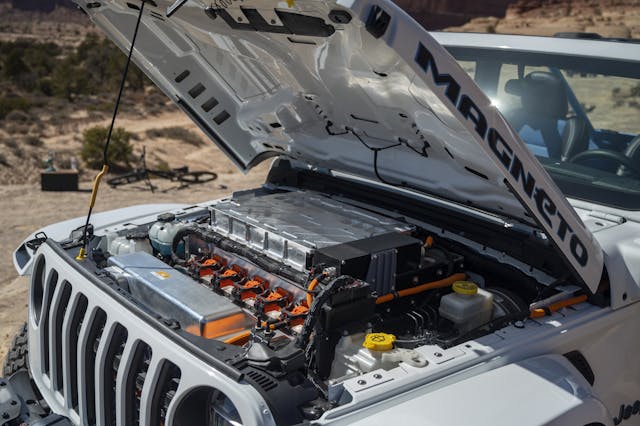
The Magneto, however, represents an interesting trail map for how Jeep might tread forward. Rather than reinvent the traditional 4×4, like GM did with the crab-walking Hummer EV, why not just treat an electric off-roader the same as an internal-combustion one? Jeep offers a wide selection of engines in the Wrangler, from the 2.0-liter four-cylinder turbo to the venerable Pentastar 3.6-liter V-6, and for those real weirdos, a 3.0-liter turbodiesel. Soon the 392 Hemi V-8 will join the party, and the hybrid 4xe is already on sale. The Magneto’s electric powertrain is just another option within the bounds of an already well-loved recipe.
For this early drivability concept, the Magneto we drove in Moab in many ways is a showroom-stock Wrangler Rubicon with the engine pulled out. Jeep instead dropped in an electric motor with 285 hp and 273 lb-ft of torque, nearly identical to the V-6’s output. Powering the e-motor are four battery packs running an 800-volt system and totaling 70 kWh, sealed inside individual machined aluminum boxes that are placed throughout the chassis. One is under the hood, another replaces the fuel tank’s spot on the frame, and another sits opposite of that through the area where the exhaust used to route through. Out back, where the muffler used to be, resides the fourth and final pack. At 5750 pounds, the Magneto concept is roughly 1500 pounds heavier than a standard gas-powered model. Otherwise it’s conventional Wrangler underneath, including the the six-speed manual transmission.
“It’s a drivetrain that you’ve probably never driven,” said Mark Allen, head of Jeep design. “Our intent with this is really just to research and ask people openly [what they want].”
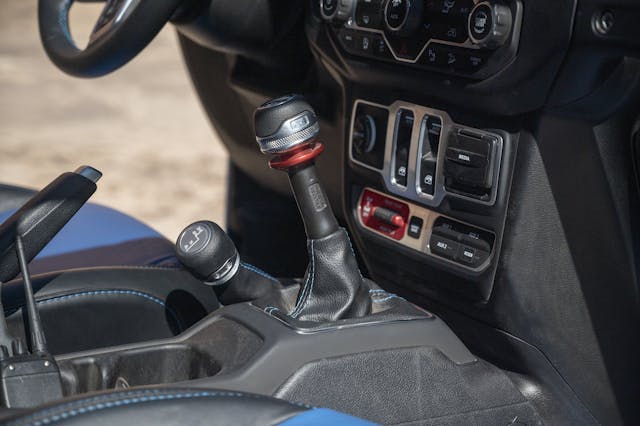
Jeep’s best guess, naturally, was that Wrangler fans would want more of the same. Very few vehicles are developed exclusively for enthusiasts like the Wrangler is, which means there is no boring version, no two-wheel-drive or independent-front-suspension derivative; every single Wrangler rolls out the door with a pair of axles tied to a 4×4 transfer case. Unlike, say, the Mitsubishi Lancer Evolution or Subaru WRX STI, which are dirt-clawing rally machines with economy car roots, even the base Wrangler is ready for action.
In off-roading, drivers highly value certain Wrangler traits, and many of these are more subtle than the Dana axles swinging below the frame. Jeep’s powertrain team, for example, has carefully calibrated the throttle to gives drivers precise low-speed modulation that feels natural. At the same time, it’s still responsive enough to open the flood gates when required, and it all happens automatically through the selected transfer case gear without requiring any special off-road modes. (Though the throttle is further tailored to low-speed driving in Off Road+.) Once the dash confirms that traction control has been disabled, it is truly out of the picture. With manual transmissions, Jeep even has dialed in a robust idle compensation for slipping the clutch until it’s just beginning to engage, which allows someone to easily creep into gear to reduce the shock-load on the tires when twisted uphill on an obstacle. Some critics decry that the Wrangler is anachronistic, but that is—again—exactly what many people are looking for.
All of these little details are what battery-pack maker Webasto worked closely with Jeep to retain. In an EV with a single-speed gearbox, torque delivery is smoothed by the tall gear ratio, which reduces the mechanical advantage of the motors over the tires, ironing out the effect of inputs and creating that long-pull slingshot feel to the powertrain. With a multi-gear transmission, like the six-speed manual in the Magneto, finesse in torque delivery becomes more vital because small changes in the motor’s output will have a big effect at the tire—like the difference between driving at 20 mph in first gear instead of second or third. This is especially true combined with a 4:1 transfer case. For perspective, Tesla’s final drive ratios have meandered as low as 7.4:1, while the current JL-generation Wrangler Rubicon’s crawl ratio is an astonishing 84.2:1 when equipped with a manual transmission and using four-low with first gear. With that short of a crawl ratio available, Webasto’s focus was on creating a torque calibration that, at least initially, would mimic the V-6’s output while also integrating the aforementioned gear- and transfer-case activated throttle maps for low-speed driving.
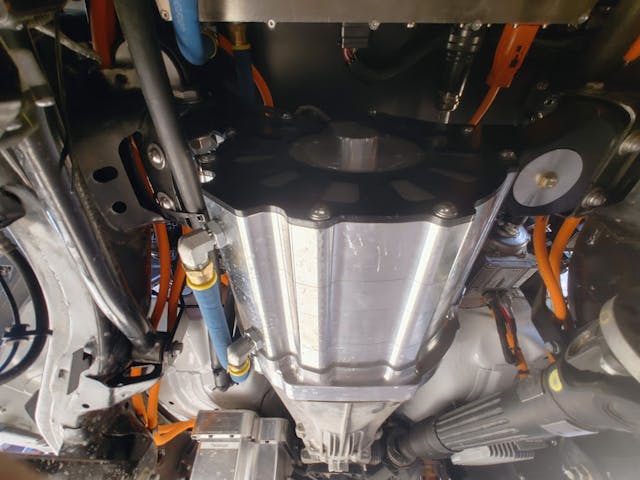
So then what makes this all-electric driving experience truly different for the off-roading fiend? Since we know that the chassis has largely been unaffected, it’s fair to say we’re judging the differences at the throttle pedal. The Rubicon’s long-travel suspension and articulation made sure Jeep’s demonstration loop posed no real challenge, but with a mix of rocky trails and sandstone stair steps, the course provided us the opportunity to click a few gears and crawl at sub-mile-per-hour speeds.
In many ways, the electric concept drives more like the EcoDiesel model than the Pentastar V-6, just without any lag in throttle response. Torque is ample and strong from the bottom end, but not jumpy. Without pistons to draw air there is no engine braking, and in its current configuration, the electric motor is allowed to freewheel. Regenerative braking could be implemented, but the lack of it allows the driver to coast with very little effort down smoother trails and dole out power in small bits to maintain momentum. Once the Magneto arrives at an obstacle, the linear torque of an electric motor shines—there’s just no comparison to that direct connection between the pedal, the motor, and the drivetrain.
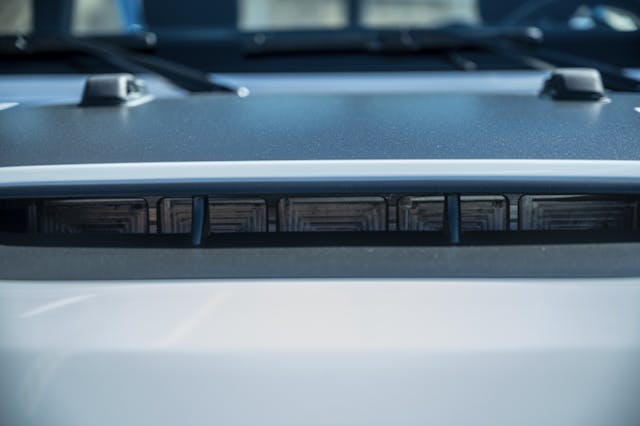
It was possible to creep the Magneto up to a point of balance on a given obstacle and hold it still using just the torque of the motor and a light amount of throttle. With a gentle lift, the Jeep rolled back slowly, resisting gravity with the tiny amount of torque we commanded, before we fed more throttle to stop it again, and crept forward. There is an ability to precisely inch the Magneto back and forth on obstacles in a manner that was like no other off-road experience. Add to the equation that the electric motor does not need to spin at idle, meaning there’s no requirement to use the clutch during these low-speed antics, where automatic transmissions usually excel. Having that manual transmissions means Jeep could tailor the power curve and response to the vehicle speed at which the Magneto operates, which is a lot different than the Power Wheels-like experience a contemporary single-speed BEV powertrain tends to yield. It’s alien at first to break the muscle memory of slipping a clutch off the line, but once you get used to it a world of possibility opens up. There’s nothing stopping you from doing the three-pedal shuffle on an obstacle if you want that challenge, but otherwise, the Magneto happily gets rolling with no drama.

Equally alien is the different flavor of engine noise; in the place of a howling V-6 is a truly sci-fi soundtrack from the electric motor winding up. Jeep and Webasto even programmed the motor to rev off the throttle pedal even while the transmission is in neutral, which an entertaining degree of control that drivers rarely get to experience over an electric powertrain. It may not bark like the 392, but the motor’s torque still throws the chassis around as the Magneto hums like a UFO. With no visceral combustion engine booming away, the mostly quiet Magneto presents a unique opportunity to really listen to the world around you—which is half the point of off-roading in a roofless, doorless Wrangler, right? It’s an accessible, adventurous way to immerse yourself in what this Earth has to offer.
As for refueling, it’s not like any of the fossil-fuel-powered Jeeps can refill while off the grid from anything larger than a portable container. It’s also plausible that enough solar panels could be strapped to the roof of an electric Wrangler to support something like an overlanding trip, where the daily mileage is relatively low and the Jeep sits as a basecamp days at a time for other activities, like mountain biking or hiking.
It’s unlikely that the all-electric Wrangler to come will resemble the Magneto exactly, but this concept is a convincing step in many ways. Battery power is compatible with off-roading in more ways than people might think, and it doesn’t have to come at the expense of tried-and-true Wrangler features or capabilities. Tailpipe emissions or not, there’s no question Jeep is striving to deliver an experience its loyal customers will love.
